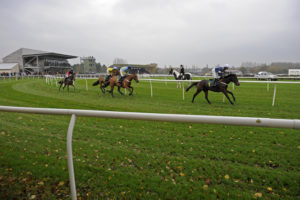How horseracing is perceived as cruel and profit-driven by outsiders has become increasingly visible, exacerbated never more than last Grand National day as celebrities took to Twitter to spread the message #YouBetTheyDie.
For Irish television presenter Sally-Ann Grassick this did not produce anger; instead it was the catalyst for launching a project aiming to show exactly how horses are looked after in racing, from birth to raceday and beyond.
She explained: “During the Grand National I saw the negative comments from celebrities and asked people not to attack them back – that’s not going to protect our industry – but to tweet them back offering to bring them to a stable yard, a racecourse or a stud farm to show them what goes on.
“If you actually opened it up to people and said, ‘Come and learn’, it’s more inclusive than saying, ‘You’re stupid and you don’t know what you’re talking about’.
“So many people responded with offers, and tweeted pictures of their retired racehorses in nice places.”
Grassick had already been inspired by the I Am Horse Racing project, launched last March in America. Using stylish videos, its aim was to introduce people to a full range of people who work in horseracing, telling unique stories across social media and online.
“It provides a link for people to whoever is hosting the account”
Its launch sparked a conversation between Grassick, vet and breeder Meta Osborne, trainer Sarah Lynam and a host of Irish racing journalists, including Aisling Crowe and Tom Malone.
They agreed that they wanted to do something similar for racing in Britain and Ireland, but how would they get funding?
“I was looking through the Ireland’s Farmers account one day and realised we could do it that way,” said Grassick. “Each week they have a different farmer tweeting for a full week about what’s going on at their farm. The account @Ireland does something similar too.
“At about the same time, another friend had said she wanted to do a self-made documentary on time spent at the sales. So many racing fans have no idea what goes on there.
“I know from working on ITV that people who are very knowledgeable about racing have no idea about what it takes to make a racehorse.
“But she was making it on a phone with a selfie stick, and there’s only so much people will watch of that before they get bored.”
Broken up over the course of a week on a Twitter feed, this idea was perfect. Thoroughbred Tales was launched on November 22 and had 1,000 followers by December 1. One week later, Godolphin Stud and Stable Staff Employee of the Year ‘Catch’ Bissett, who works for trainer Nick Alexander, took over as the first guest host.
Great content from this week’s @ThoroughbrdTale guest host @shirlsy from the @tattscheltenham January Sale and many thanks to @CoddJJ for providing such great info to our followers.
Let’s promote positive messages about our industry, join the #ThoroughbredTales project! https://t.co/ZpQJz5m4XW— Sally Ann Grassick (@sagrassick) January 24, 2020
“She was unbelievable,” said Grassick. “She had planned out exactly what she wanted to cover on each day of the week and the insight she gave was incredible. She was so good, she actually put people off hosting, because they didn’t want to follow her!”
Today @ThoroughbrdTale has more than 3,000 followers and a schedule of hosts, designed to get to the heart of the biggest events. In early January, it was Stephanie McGlynn on the Gold Coast in Australia, giving insight into the yearling sales, and during the Cheltenham Festival it’s likely to be trainer Noel Meade’s long-serving head lass Emma Connolly.
“The other idea of the account is that it provides a link for people to whoever is hosting the account,” Grassick said. “The direct messages are open, the Tweets are open. Anyone who wants to can directly contact the account.”
Grassick’s main aim is to “get ahead of the welfare thing, rather than putting out fires” and to that end she also wants to provide training to racing professionals about how to deal with social media negativity.
“I saw the negative comments from celebrities and asked people not to attack them back”
“I am in the process of trying to bring sports journalism students to a racing yard and then a race meeting, to show them what goes on,” she said. “It’s a question of educating, and if they can educate themselves about horseracing, they’ll be able to support racing, rather than just follow negativity on Twitter.”
She added: “I’ve offered to do media training with students in RACE, and it’s also very important to do social media training. A jockey should be trained in how to deal with trolls, because even for me it’s an everyday job.”
Lumped in with the horse welfare category is the whip – some have even said they believe that the whip will not be used in horseracing within a decade. Grassick does not want to see that happen and believes the terminology is the simplest way to alter perceptions.
“The whip is something the average person thinks about, purely because it’s called the whip,” she said. “I got a taxi back from Ascot the other day and the driver said he didn’t think the whip was anything bad, but that it does sound cruel. Once I’d explained it all, he understood.” conversation from a negative perspective.”



